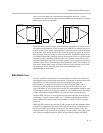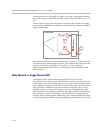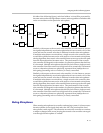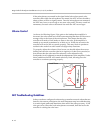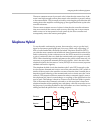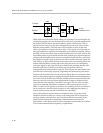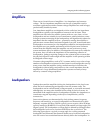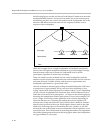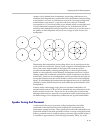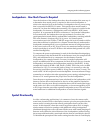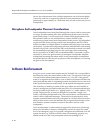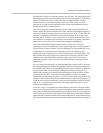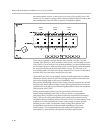
Designing Audio Conferencing Systems
B - 23
Another rule of thumb about loudspeaker positioning with listeners is to
distribute the loudspeakers no greater than twice the distance from the ceiling
to the listener's ear level. In a conference room with 9 foot high ceilings and
seated listeners' ears about 3 ½ feet above the floor, this rule of thumb
corresponds to a 5½ foot from ceiling to ear distance which corresponds to an
11 foot loudspeaker separation from ceiling to ear. If the listeners will be
standing, more loudspeakers will be required to effectively cover the room as
the pattern of the loudspeaker will not cover as large an area closer to the
loudspeaker.
Distributing the loudspeakers in the ceiling allows for all participants in the
room to hear the sound well. If there is only a single set of loudspeakers in the
front of the room, then the audio in the back of the room may sound
reverberant and muddy, reducing intelligibility for the local participants.
Similar to a microphone's critical distance, loudspeakers also have a critical
distance where the reverberant sound field is equal in intensity to the direct
sound field. If there are few loudspeakers (such as positioned at the front of a
room), then listeners near the critical distance will not receive an intelligible
signal. By distributing the loudspeakers throughout the room, it is generally
possible to ensure that all listeners are well within the critical distance of the
loudspeakers.
In many audio conferencing rooms, there are separate loudspeakers for
program audio such as VCR or DVD to maintain the stereo separation of the
source material in the room. There can also be a subwoofer for this media,
although subwoofers are typically not required for audio conferencing due to
the limited range of low frequencies produced by the typical human talker.
Speaker Zoning And Placement
As discussed in the previous section, ceiling loudspeakers should be
positioned so the sound field from the loudspeaker encompasses the
participants' seating locations. This typically means that the loudspeakers are
positioned outside of the table perimeter to allow coverage of the participants
and any potential areas of overflow seating as shown in one possible layout of
a room that is approximately 33x20 feet (approximately 700 sq. ft.) in the



